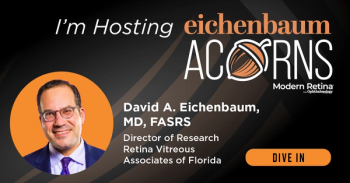
Phase 3 PULSAR Study: Aflibercept 8 mg Monotherapy for PCV: Robust Efficacy Benefits
A subgroup analysis of the phase 3 PULSAR Trial showed robust increases in the best-corrected visual acuity (BCVA) compared with baseline at week 48.
Reviewed by Chui Ming Gemmy Cheung, MD
A subgroup analysis of the phase 3 PULSAR Trial, which evaluated intravitreal aflibercept 8-mg monotherapy (Eylea, Regeneron Pharmaceuticals) compared to aflibercept 2 mg to treat polypoidal choroidal vasculopathy (PCV), showed robust increases in the best-corrected visual acuity (BCVA) compared with baseline at week 48. PCV, which is characterized by abnormal choroidal vascular networks ending in polyps and is considered a variant of type 1 choroidal neovascularization, is particularly prevalent in Asian populations, according to Chui Ming Gemmy Cheung, MD.
These results were seen in all 3 dosing arms of the study. Cheung reported the results on behalf of the PULSAR study investigators. She is from the Duke-NUS Medical School, National University of Singapore, and presented the study results at the 2023 Euretina Congress in Amsterdam.
The PULSAR Trial is a, randomized, double-masked, multicenter, 96-week, of patients with treatment-naïve neovascular age-related macular degeneration (nAMD). The week-47 results were presented.
In this study, patients with treatment-naïve nAMD were randomized 1:1:1 to 1 of 3 dosing arms: 2 mg aflibercept every 8 weeks (336 patients) and 8 mg aflibercept every 12 (335 patients) or every 16 weeks (338 patients).
The primary endpoint was the change in the BCVA at week 48. A key secondary endpoint was the proportion of patients without intra- or sub-retinal fluid in the central subfield at week 16.
The study endpoint was week 96 and an optional 1-year extension extended out to week 156.
PCV subgroup
A total of 141 patients with PCV confirmed with indocyanine green angiography were identified in the PULSAR population.
The mean age in the PCV subgroup was 72.6 years, 43.7% were women, and the mean BCVA letter score was 58.3. The mean central retinal thickness was 383 microns.
Cheung reported the following changes in the 3 arms of the PCV subgroup: increases of 9.5 letters in the aflibercept 2 mg every-8-week group, 9.3 letters in the aflibercept 8 mg every-12-weel group, and 8.5 letters in the aflibercept 8 mg every-16-week group.
The investigators also determined the proportions of patients who were maintainedon the every-12-week and every-16-week intervals through week 48. The percentages in the PCV subgroup were 79% and 87%, respectively, in the every-12 and every-16-week groups. Among all the patients randomized to aflibercept 8mg, 86% maintained treatment intervals of 12 weeks and longer.
Among patients randomized to aflibercept 8 mg, the proportion of patients without retinal fluid in the central subfield at week 16 was 68% in the PCV subgroup and 63% in the overall study population.
Along with the increases in BCVA, concomitant decreases were seen at week 48 in the central retinal thickness in the 3 PCV arms: 146 microns in the aflibercept 8 mg group treated at 16-week intervals, 148 microns in the aflibercept 2 mg group treated at 8-week intervals, and 171 microns in the aflibercept 8 mg group treated at 12-week intervals.
The safety profile of aflibercept 8 mg was similar in patients with PCV and the overall PULSAR nAMD population compared to the known safety profile of 2 mg aflibercept.
The study concluded that aflibercept 8 mg monotherapy showed robust efficacy benefits, the vast majority of patients were maintained on treatment intervals of 12 weeks or longer, and the 8-mg dose showed a safety profile similar to the 2-mg dose.
“The response of PCV to anti-VEGF monotherapy can be more variable than in typical nAMD. These results are very encouraging in terms of visual improvement. Furthermore, the high proportion of patients who maintained a 12-week or longer retreatment interval will certainly reduce retreatment burden in clinical practice,” Cheung concluded.
Chui Ming Gemmy Cheung, MD
E: gemmy.cheung.c.m@singhealth.com.sg
She has received consultant fees, speaker fees and grant funding from Bayer, Roche, Novartis, Boehringer Ingelheim, Topcon, Zeiss, Janssen, and Avirmax.The PULSAR study was sponsored by Bayer AG (Leverkusen, Germany) and co-funded by Regeneron Pharmaceuticals, Inc.
Newsletter
Keep your retina practice on the forefront—subscribe for expert analysis and emerging trends in retinal disease management.












































